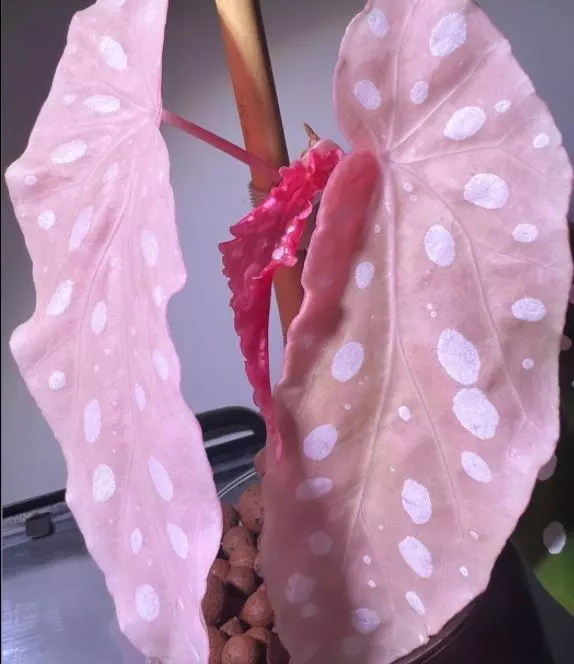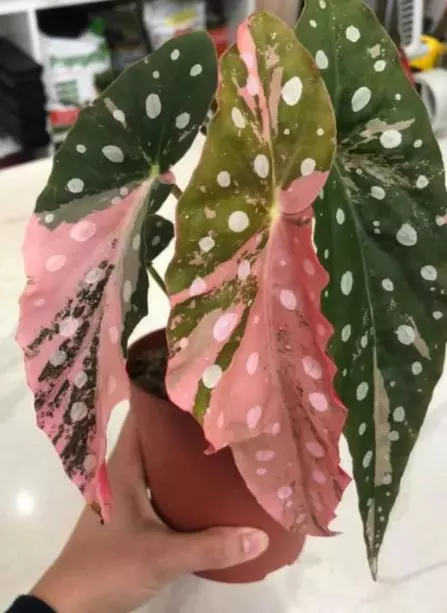Pink Begonia maculata (Begonia roseopunctata) is the Pink Polka Dot Plant. The Begonia maculata is a complete houseplant: exotic, decorative, grateful, and with a special feature compared to those seen before: it produces beautiful flowers (oh yeah, even indoors!).
Begonia Roseopunctata comes from the tropical areas of South America, and its scientific name is Begonia Roseopunctata. The most widespread meaning, “Maculata”, responds to the silvery spots on its leaves, as macula means “spot” in Latin.
Besides having an original appearance, Pink Begonia maculata is very interesting for indoor cultivation because of its small size and its particular way of growing: its leaves fall in a cascade from a central trunk of reduced size.
Table of Contents
Pink Begonia maculata Care
Pink Begonia maculata care is manageable and does not involve great difficulty. But let no one is deceived. We are talking about a tropical plant cultivated as part of our houseplants and in latitudes quite different from the place where it originates. A detail that we cannot lose sight of, since they mark their needs in a couple of decisive aspects for their well-being.
If you want to know more about Begonia we recommend our article about Begonia maculata wightii – Polka Dot Begonia Care & How to Propagate Begonia maculata.
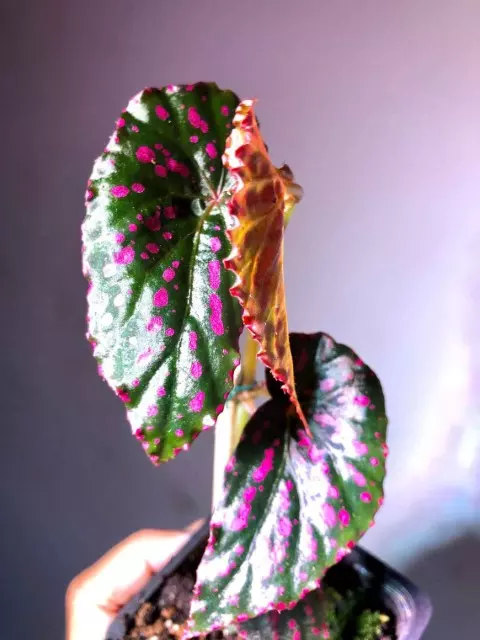
Temperature for Begonia Roseopunctata
Let’s start with one of the Pink Begonia maculata care that we must keep a close eye on. And let’s make it clear from the start: no, it is not a cold-tolerant plant. A reason why it is often grown indoors and, also, one of the reasons that can compromise its well-being.
The ideal temperature for this exotic begonia is 68 °F (20 °C). It also supports high temperatures, although it is necessary to be careful. The fact that it can withstand them does not mean that they are good for it. Therefore, if we live in a very hot climate, the idea is to place it in a cool place and increase the watering pattern.
As for its minimum temperature, it is not advisable to subject it to less than 62 °F (17 °C) degrees. After that, its growth stops, and it can lose its leaves.
Light for Pink Begonia Maculata
Knowing that it is originally from the Sudamerica plant, we have an idea of its light needs. The Begonia Roseopunctata needs a lot of light, but never direct sun. This could burn its precious and unique leaves.
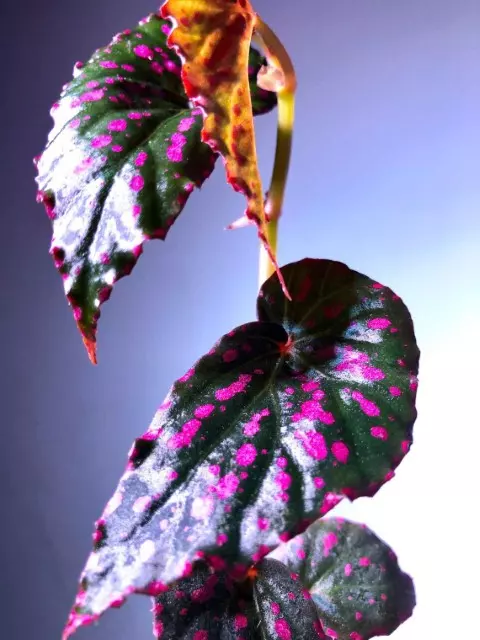
Watering Pink Begonia maculata, Always Moderate
Watering Pink Begonia maculata: Moderate. Although Begonia Roseopunctata is a plant of tropical origin, it does not tolerate excess humidity. What’s more, it is one of the main causes of death of this plant, since the roots tend to rot. A detail that we must know to avoid is that this is our destiny of ours, and that forces us to remove the lower plate of the pot. And no: we do not have to spray its leaves, either. It indeed demands environmental humidity, but achieving it is as simple as grouping it with other plants.
To avoid this excess of irrigation, the ideal is to be guided by the substrate. Although it must indeed be dry before watering, two weekly watering will be enough in the hot months and once a week the rest of the year.
Good drainage must be a real priority for the cultivation of Pink Begonia maculata. This is the only way to ensure proper water drainage. And, to promote it, nothing like choosing among the different types of pots a clay one. A porous material that, in addition, does its bit in the evaporation of excess moisture.
- Growing indoors is easy under the right conditions; Miracle-Gro Houseplant Potting Mix combines key elements plants need to thrive
- Recommended for growing beautiful indoor houseplant varieties like Pothos, Spider Plants, Monstera, Philodendron, English Ivy and more
- This indoor plant soil is less prone to gnats, thanks to the combination of perlite, sphagnum and peat moss that's just right
Fertilization Essential to Support Flowering
One of the Pink Begonia maculata care that we will have to note on the calendar. With the arrival of spring, it is important to apply a regular dose of fertilizer. Thanks to it, we will promote flowering but also help the plant in the most energy-consuming time of the year.
To fertilize Pink Begonia maculata correctly, use a mineral fertilizer for flowering plants, guano, or a universal fertilizer for plants. As for the pattern, it is simple to follow: we will keep it until the end of the summer.
- Designed to produce more flowers and brighter colors on all indoor and outdoor plants, Blossom Booster 10-30-20 is a professional formula that feeds through both the roots and the leaves.
- This formula is guaranteed to produce amazing results with its proven 1:3:2 nutrient ratio creating the quality that is unmatched in the home gardener market.
- This1.5 lb. tub of Blossom Booster can be used as transplant solution and is best for use on all indoor and outdoor flowering plants including geraniums, impatiens, begonias, marigolds, vegetable and fruits.
Repotting Pink Begonia maculata, Once A Year and In Spring
Do not be fooled by the average size of Pink Begonia maculata. It is true that we are talking about a slow-growing plant, and that it grows more in width than in height. To promote that it has the nutrients it needs, it is advisable to transplant once a year at a very specific time: in spring.
In addition to this, there are other considerations for transplanting. To begin with, the type of substrate. The ideal for Pink Begonia maculata is a very specific mixture: 50% black peat, and 50% perlite. In this way, we will have porous soil that, in addition, drains well.
The other aspect of interest is the size of the pot. It will be enough if it is a maximum of 1.6” (4 cm) larger in diameter. It is not advisable to change it to a pot that exceeds these dimensions. Although it will indeed need space to grow, it is more important that the growth of its roots is orderly.
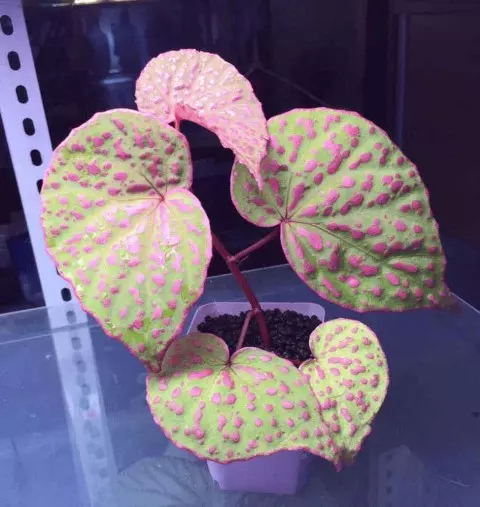
How to Propagate Pink Begonia maculata
How to Propagate Pink Begonia maculata. We leave for the end one of the aspects that usually arouse curiosity: the propagation of Pink Begonia maculata. An aspect that will allow us to be able to have twin plants to ours, and propagate this precious wonder of nature.
The propagation of Begonia Roseopunctata involves knowing how to make cuttings that grow successfully. This is the only way to be able to reproduce it, but it also has its particularities. It is important to do it in winter: the time of vegetative rest of the plant. And just as important is to know how to make it thrive: placing the stem in a glass of water until it has a good number of roots. Then, the Begonia Roseopunctata plant will be time to repot it into a pot with a substrate.
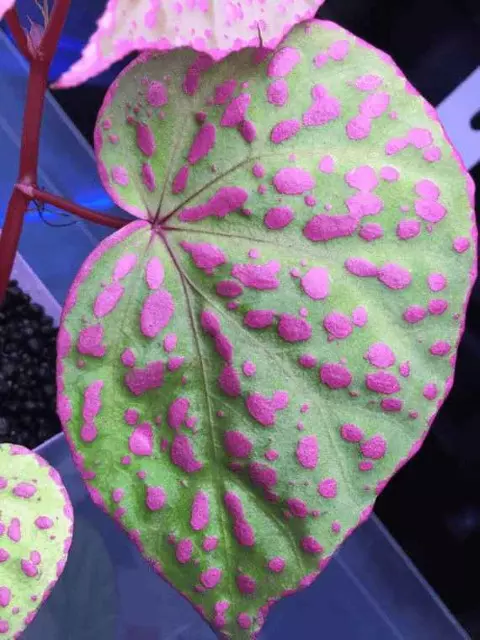
Begonia maculata Pink Splice
Sometimes the leaves of a Polka Dot Plant Begonia maculata turn pink, and people may confuse it, incorrectly thinking that it is a Pink Begonia maculata (Begonia roseopunctata) but it is not. It is usually called Begonia maculata Pink Splice.
The Pink Begonia maculata has pink dots, instead of white dots. Some Polka Dot Plant Begonias change the color of their leaves when fertilizer is needed, and it’s what we usually called Begonia maculata Pink Splice.
